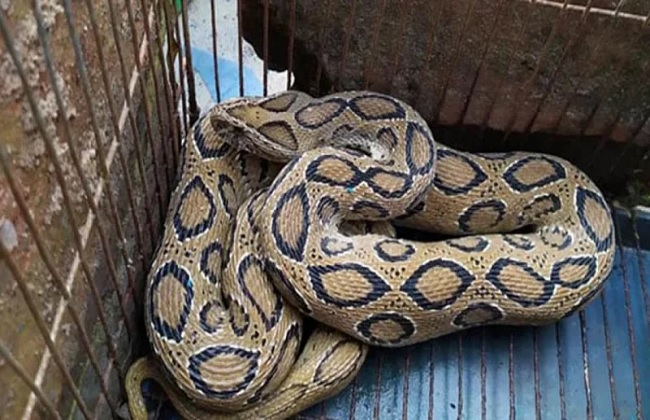
The Russell’s viper was long thought to be nearly extinct in Bangladesh, where it is known as chandra bora, until about a decade ago. Wildlife biologists were unaware of the Russell viper’s (Daboia russelii) prevalence until 2013, even though the snake has been recorded in the region for a century. But its current comeback represents a grave danger to the local people’s lives.
The viper is mostly seen in Bangladesh during the rice harvesting season. This year, the incidents of Russell’s vipers’ insurgence and snakebites came to the forefront during the months of May and June, which is the country’s most important rice harvesting season of the Boro crop.
Though there is no exact figure of the death toll due to Russell’s vipers’ bites in the country, people are terrified of the snake across the country, especially those who work in agricultural fields. Consequently, when any snake is spotted, locals rush to kill it rather than trying to check if it is venomous or not.
A study linked the snake’s insurgence with the intensified cropping pattern, which increased the number of rats — the snake’s primary food — in the field. This ensured an advantage that may have helped in the population increase of the snake, but it is hard to pinpoint the precise cause of this population boom in Bangladesh.
According to the study, only nine districts — Dinajpur, Chapai Nawabganj, Rajshahi, Naogaon, Natore, Pabna, Rajbari, Chuadanga and Patuakhali — have recently reported sightings of Russell’s vipers, while earlier data indicated the presence of the viper species in 11 districts — Nilphamari, Dinajpur, Rangpur, Chapai Nawabganj, Rajshahi, Bogura, Jeshore, Satkhira, Khulna, Bagerhat and Chittagong.
Out of Bangladesh’s 64 districts, Chapai Nawabganj and Rajshahi’s citizens have been the most severely affected, with at least 20 people dying from Russell’s viper bites since 2013.
Due to the shortage of water required for crop cultivation before the 1990s, farmers often only cultivated one or two crops per year, leaving the land fallow for the remainder of the year. Post 1990s, due to the introduction of irrigation systems and a reduction in the area of land left fallow, farmers began farming two to three crops in a year.
According to Md. Farid Ahsan, a professor in the department of zoology at the University of Chittagong, who leads the study on the resurgence of the Russell’s viper, because crops are available for a large portion of the year and rats, the main food source of the Russell’s viper, are present in the crop fields, the viper has more opportunities for reproduction and population growth.
Snakes, snakebite, and treatment in Bangladesh
According to Bangladesh National Guideline for Management of Snakebite, there are approximately 100 species of snakes in Bangladesh, of which 16 species of sea snakes, three types of cobras (including the king cobra), five types of kraits, two species of coral snakes, six species of green pit vipers, and one species of true viper (the Russell’s viper) are venomous.
According to a survey conducted in 2023, about 7510 people are killed by snakebites annually in Bangladesh. The majority of bites that occur during the monsoon season are associated with agricultural work-related activities.
Considering the danger, Bangladesh established a Venom Research Institute in 2018, working to invent anti-venom for specific snakes.
Aniruddha Ghose, the principal investigator at Venom Research Centre in Bangladesh, told Mongabay, “Developing anti-venom is time-consuming, and we are still in the research stage of developing antibodies against different venomous snakes.”
He added that the major challenges in diagnosing snakebites are people’s ignorance and inability to identify the snake and the lack of serological tests to identify the presence of venom in the victim’s sample.
“Consequently, our treatment depends on the evidence provided by victims and witnesses, which, in most cases, proves false,” said Ghose, who is also a professor at Chittagong Medical College.
When snakebites meet specific criteria, the current national snakebite guideline suggests using antivenom imported from the neighboring India, which works to some extent.
Considering the consequences, this year, the government is promoting awareness about why snakes shouldn’t be killed and is promoting information about snakebites through content on social media and mobile apps.
Regarding this, Md. Shohel Rana, a herpetologist at the Sheikh Kamal Wildlife Centre of the Bangladesh’s forest department, told Mongabay, “This year, the forest department itself posted several awareness materials on Facebook about venomous snakes like Russell’s vipers and about non-venomous snakes, too, and the treatment of snakebites. At the same time, the post requested the people not to kill any snakes.”
Apart from all of this, to make the information available and create more awareness among the common people, the government has already developed a mobile phone-based application named Awareness in Snakebites, which is available in the app stores for both Android and Apple phones.
(This article is republished from Mongabay under Creative Commons License)
Abu Siddique is Mongabay’s Contributing Editor for Bangladesh. He has worked for several of the leading national dailies including Dhaka Tribune, Daily Sun and The Business Standard, and has explored the remotest corners of the country in search of stories.

